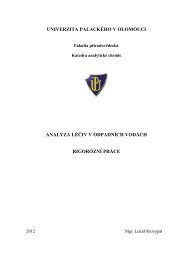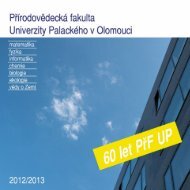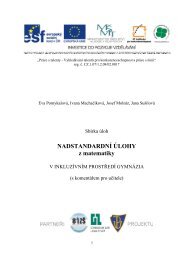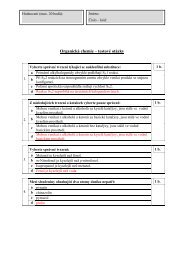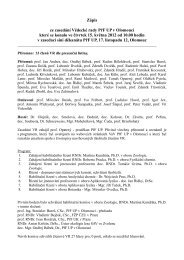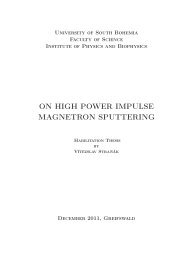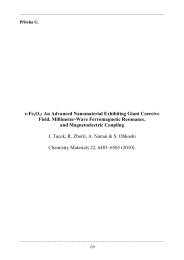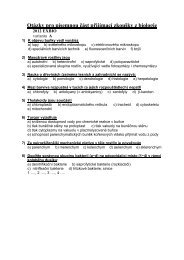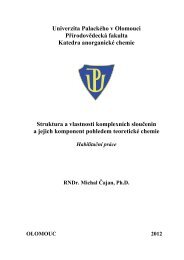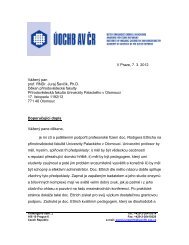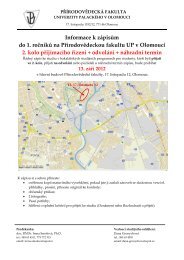A comparative structural analysis of direct and indirect shoot ...
A comparative structural analysis of direct and indirect shoot ...
A comparative structural analysis of direct and indirect shoot ...
Create successful ePaper yourself
Turn your PDF publications into a flip-book with our unique Google optimized e-Paper software.
M. OVECKA & M. BOBAK<br />
et al. 1997/98). Surface pattern <strong>of</strong> clustered secondary<br />
somatic proembryos <strong>and</strong> globular embryos<br />
originating from activated hypocotyl cells (Ove~ka<br />
et al. 1997/98) expressed similar developmentally<br />
regulated cell connection <strong>and</strong> surface patterning <strong>of</strong><br />
proembryos <strong>and</strong> globular embryos described here.<br />
The protoderm <strong>of</strong> somatic embryos from the globular<br />
stage with the special cell shape <strong>and</strong> tight cell adhesion<br />
lacked such external wall structures found<br />
common for all regenerated organs covered by epidermis<br />
(<strong>shoot</strong>s <strong>and</strong> leaves in organogenic culture).<br />
Our observations <strong>of</strong> early stages during somatic<br />
embryogenesis are in agreement with spatial <strong>and</strong><br />
temporal cell-to-cell communication responsible<br />
for a co-ordinated embryonic pattern expression<br />
before globular stage previously published. Cells in<br />
the embryogenic tissue during development <strong>of</strong> the<br />
globular embryos were linked with the fibrillar<br />
structure before acquisition <strong>of</strong> tight adhering cell<br />
contacts, but somatic embryos from the globular<br />
stage were free <strong>of</strong> such structure in C<strong>of</strong>fea arabica<br />
(Sondahl et al. 1979), in <strong>direct</strong> somatic embryogenesis<br />
<strong>of</strong> Cichorium from root (Dubois et al. 1990,<br />
1992) <strong>and</strong> leaf tissue (Dubois etal. 1991) <strong>and</strong> in in<strong>direct</strong><br />
somatic embryogenesis <strong>of</strong> Drosera <strong>and</strong> Zea<br />
(Samaj et al. 1995). In Cichorium, the extracellular<br />
matrix <strong>of</strong> tubular structure (Verdus et al. 1993) were<br />
shown <strong>of</strong> a glycoprotein nature functionally interconnecting<br />
the cytoskeleton (Dubois et al. 1992).<br />
The continuum crossing the cell wall <strong>and</strong> the<br />
plasma membrane <strong>and</strong> especially extracellular matrix<br />
within this continuum were precisely characterised<br />
in polarity fixing during Fucus embryogenesis<br />
(see Goodner <strong>and</strong> Qatrano 1993, Brownlee <strong>and</strong><br />
Berger 1995).<br />
Expression <strong>and</strong> co-ordination <strong>of</strong> embryonic development<br />
especially establishment <strong>and</strong> maintenance<br />
<strong>of</strong> cell division pattern could be (or must be) regulated<br />
by embryo-intrinsic mechanisms requiring effective<br />
signalling machinery in the stage <strong>of</strong> somatic<br />
proembryo when cells are still undifferentiated.<br />
Cell signalling must be able to block some signals<br />
during cell determination but widely spread other<br />
signals during subsequent development. Stagedependent<br />
regulation <strong>of</strong>J4e epitope expression recognised<br />
by JIM4 antibody was shown in somatic<br />
embryogenesis <strong>of</strong> carrot (Stacey et aI. 1990). The<br />
epitope expressed in single cultured cells was re-<br />
expressed by cells at the periphery <strong>of</strong> developing<br />
cell clusters in embryogenesis-promoting conditions<br />
<strong>and</strong> subsequently the expression in the protoderm<br />
cells <strong>of</strong> the globular somatic embryo was detected<br />
(Stacey etal. 1990). Developmental <strong>and</strong> spatial<br />
cell regulation through cell surface epitopes is<br />
documented also by emerging data on involvement<br />
<strong>of</strong> some AGPs in cell-cell signalling <strong>and</strong> cellmatrix<br />
interactions during tissue development <strong>and</strong><br />
cell proliferation (Duet al. 1996 for a review). In<br />
embryogenic clumps <strong>of</strong> carrot callus, cell position<br />
<strong>and</strong> cell type-specific distribution <strong>of</strong> AGP epitope<br />
at the plasma membrane <strong>of</strong> the superficial cells <strong>of</strong><br />
the clump were shown (Knox 1990). In Cichorium<br />
two embryogenesis-specific proteins absent in<br />
non-embryogenic line were detected <strong>and</strong> their presence<br />
was correlated with formed external glycoprotein<br />
fibrillar network (Hilbert et al. 1992). From<br />
this point <strong>of</strong> view any <strong>structural</strong> components <strong>of</strong> extracellular<br />
matrix (Sondahl et al. 1979, Goodner<br />
<strong>and</strong> Qatrano 1993, Brownlee <strong>and</strong> Berger 1995,<br />
Dubois et al. 1991, 1992, Samaj et al. 1995, <strong>and</strong><br />
structures reported here) could be evaluated as an<br />
integral part <strong>of</strong> the signalling cascade through extracellular<br />
matrix-plasmomembrane-cytoskeleton<br />
continuum (Reuzeau <strong>and</strong> Point-Lezica 1995) allowing<br />
peripheral proembryo cells to be involved in<br />
co-ordinated development. Temporal occurrence <strong>of</strong><br />
external matrix in developmentally restricted stage<br />
indicates its important role in fixing <strong>of</strong> cell position<br />
<strong>and</strong> in morphogenesis before the protodermis formation.<br />
The differentiated protodermis was free <strong>of</strong><br />
fibrillar <strong>and</strong> tubular network (Fig. I g, Sondahl et al.<br />
1979, Dubois et al. 1992, Samaj et aL 1995) while<br />
other protoderm-specific marker expressions<br />
within the somatic embryo could be detected such<br />
as EP2 expression in carrot encoding a lipid transfer<br />
protein (Sterk et al. 1991).<br />
Arrangement <strong>of</strong> embryogenic cell clusters indicate<br />
association <strong>of</strong> individual proembryos rather than<br />
globular appearance <strong>of</strong> meristemoids in the organogenic<br />
culture where cell layer specialisation precedes<br />
the <strong>shoot</strong> regeneration (Ovetka et al. 1997).<br />
Plane <strong>of</strong> cell division r<strong>and</strong>omly oriented within the<br />
meristemoids was associated with initiated morphogenetic<br />
program <strong>of</strong> cells activated for regeneration,<br />
still undifferentiated, but keeping a tight cell<br />
adhesion within the meristemoid lacking any inter-<br />
124




